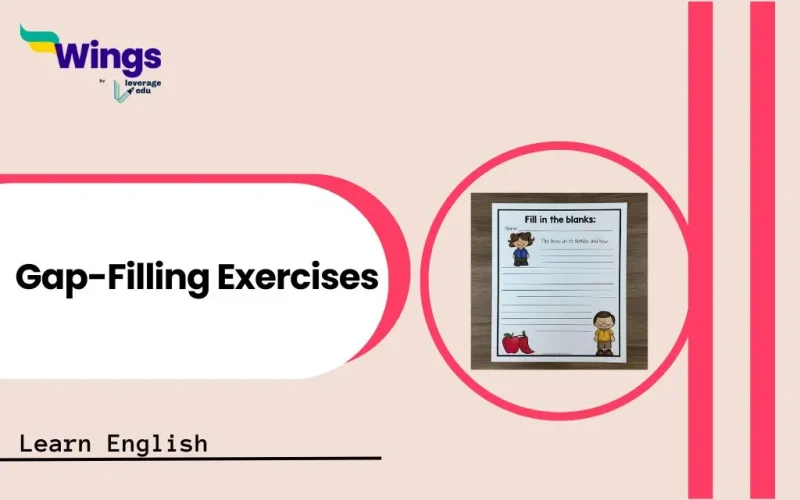Gap-filling exercises are one of the best ways to enhance your grammar, vocabulary, and overall language skills. Whether you are a student preparing for exams, an English learner looking to improve fluency, or a professional aiming to sharpen communication skills, these exercises provide an engaging and effective method for language development.
They challenge your ability to understand sentence structures, use the right words in context, and apply grammar rules effortlessly. By practicing regularly, you can boost your confidence in writing, reading, and even speaking, making everyday communication smoother and more precise.
This Blog Includes:
What Are Gap-Filling Exercises?
Gap-filling exercises are sentences or passages with missing words. The challenge is to fill in the blanks with the correct words based on the context. These exercises help in improving grammar, sentence structure, and word usage.
Benefits of Solving Gap-Filling Exercises
Practicing gap-filling exercises can significantly enhance your language proficiency. They provide a structured way to learn and reinforce essential grammar and vocabulary skills.
- Enhances Vocabulary – By regularly practicing these exercises, you get exposed to new words and their meanings.
- Improves Grammar – These exercises help reinforce grammar rules, including tenses, prepositions, and conjunctions.
- Boosts Reading Comprehension – Understanding the sentence context before filling in the blanks enhances reading skills.
- Develops Writing Skills – Learning how to use words correctly helps in writing grammatically sound sentences.
- Strengthens Confidence – Regular practice makes it easier to construct proper sentences in conversations and writing.
Types of Gap-Filling Exercises
There are different types of gap-filling exercises, including:
- Grammar-based: Focus on tenses, articles, prepositions, and conjunctions.
- Vocabulary-based: Requires inserting synonyms, antonyms, or contextually appropriate words.
- Cloze Tests: A passage with multiple missing words where you infer the right words from context.
Also Read: English Grammar for Class 10 Important Topics
How to Solve Gap-Filling Exercises Effectively
Mastering gap-filling exercises requires understanding context and grammar rules. Here are some essential tips to improve accuracy and speed.
- Read the Entire Sentence Carefully – Understand the sentence’s meaning before filling in the blank.
- Identify Clues – Look at the words before and after the blank to determine the correct word.
- Think About Grammar Rules – Consider tense, subject-verb agreement, or prepositions needed.
- Eliminate Wrong Options – If given choices, remove obviously incorrect answers to find the best fit.
- Practice Regularly – The more you practice, the better you become at understanding patterns and usage.
Check out: Direct and Indirect Speech Worksheet
Gap-Filling Exercises
Here are different types of gap-filling exercises for various learning levels and topics:
General Gap-Filling
Fill in the blanks with the correct words:
- She ______ (go/goes/went) to the park every morning
- I have never ______ (see/seen/saw) such a beautiful sunset.
- The cat is hiding ______ (on/in/under) the table.
- They ______ (has/have/had) completed their project on time.
- He is ______ (taller/tallest/tall) than his brother.
- We ______ (was/were/are) excited about the trip.
- The book is ______ (on/over/under) the desk.
- She ______ (speak/speaks/spoke) three languages fluently.
- He ______ (don’t/doesn’t/didn’t) like spicy food.
- The train ______ (arrives/arrived/arrive) at 10 AM every day.
Answers:
- She goes to the park every morning.
- I have never seen such a beautiful sunset.
- The cat is hiding under the table.
- They have completed their project on time.
- He is taller than his brother.
- We were excited about the trip.
- The book is on the desk.
- She speaks three languages fluently
- He doesn’t like spicy food
- The train arrives at 10 AM every day.
Vocabulary-Based Gap-Filling
Fill in the blanks with the appropriate word from the box.
(improve, beneficial, maintain, healthy, avoid, consume)
- To stay fit, it is important to ______ a balanced diet.
- Drinking plenty of water is ______ for your body.
- You should ______ junk food to prevent health issues.
- Regular exercise helps to ______ your physical fitness.
- Fruits and vegetables are essential to ______ your immune system.
- It is important to ______ nutritious food for overall well-being.
Answers:
- To stay fit, it is important to maintain a balanced diet.
- Drinking plenty of water is beneficial for your body.
- You should avoid junk food to prevent health issues.
- Regular exercise helps to improve your physical fitness.
- Fruits and vegetables are essential to boost your immune system.
- It is important to consume nutritious food for overall well-being.
Tenses-Based Gap-Filling
Complete the sentences with the correct form of the verb in brackets.
- She ______ (go) to the market every Sunday.
- While I ______ (study), my brother was watching TV.
- By next year, they ______ (complete) their project.
- He ______ (not meet) his friend since last summer.
- When I reached home, my mother ______ (cook) dinner.
Answers:
- She goes to the market every Sunday.
- While I was studying, my brother was watching TV.
- By next year, they will have completed their project.
- He has not met his friend since last summer.
- When I reached home, my mother was cooking dinner.
Preposition-Based Gap-Filling
Fill in the blanks with appropriate prepositions.
- She is interested ______ learning new languages.
- The book is lying ______ the table.
- I have been waiting ______ you for an hour.
- He was punished ______ breaking the rules.
- We will meet ______ 5 PM tomorrow.
Answers:
- She is interested in learning new languages.
- The book is lying on the table.
- I have been waiting for you for an hour.
- He was punished for breaking the rules.
- We will meet at 5 PM tomorrow.
Context-Based Gap-Filling (Reading Comprehension)
Read the passage and fill in the blanks with suitable words.
John was very excited about his trip to the mountains. He packed his bag with all the necessary items, including warm clothes, food, and a ______ (1) for navigation. The weather was chilly, but he enjoyed the fresh air and beautiful ______ (2). As he climbed higher, he saw a small hut where he decided to take a short ______ (3). After resting for a while, he continued his journey, feeling ______ (4) and refreshed.
Answers:
John was very excited about his trip to the mountains. He packed his bag with all the necessary items, including warm clothes, food, and a map (1) for navigation. The weather was chilly, but he enjoyed the fresh air and beautiful scenery (2). As he climbed higher, he saw a small hut where he decided to take a short rest (3). After resting for a while, he continued his journey, feeling energised (4) and refreshed.
Also Read: Preposition Exercises for Class 10 for Practice
FAQs
Gap-filling exercises are used to improve vocabulary, grammar, and sentence structure. They help learners develop better language comprehension and writing skills.
These exercises enhance your ability to use words in context, reinforce grammatical rules, and improve reading and writing fluency.
Yes, they are beneficial for students, professionals, and anyone looking to improve their English skills. They can be tailored to different proficiency levels.
Absolutely! Many competitive exams, such as IELTS, TOEFL, and SAT, include gap-filling tasks to assess language proficiency.
The most common types include grammar-based, vocabulary-based, and cloze tests, which focus on different aspects of language learning.
Solve other English Grammar exercises:
You can also follow the Learn English page of Leverage Edu for more exciting and informative blogs related to English grammar and the English language
 One app for all your study abroad needs
One app for all your study abroad needs















 60,000+ students trusted us with their dreams. Take the first step today!
60,000+ students trusted us with their dreams. Take the first step today!

